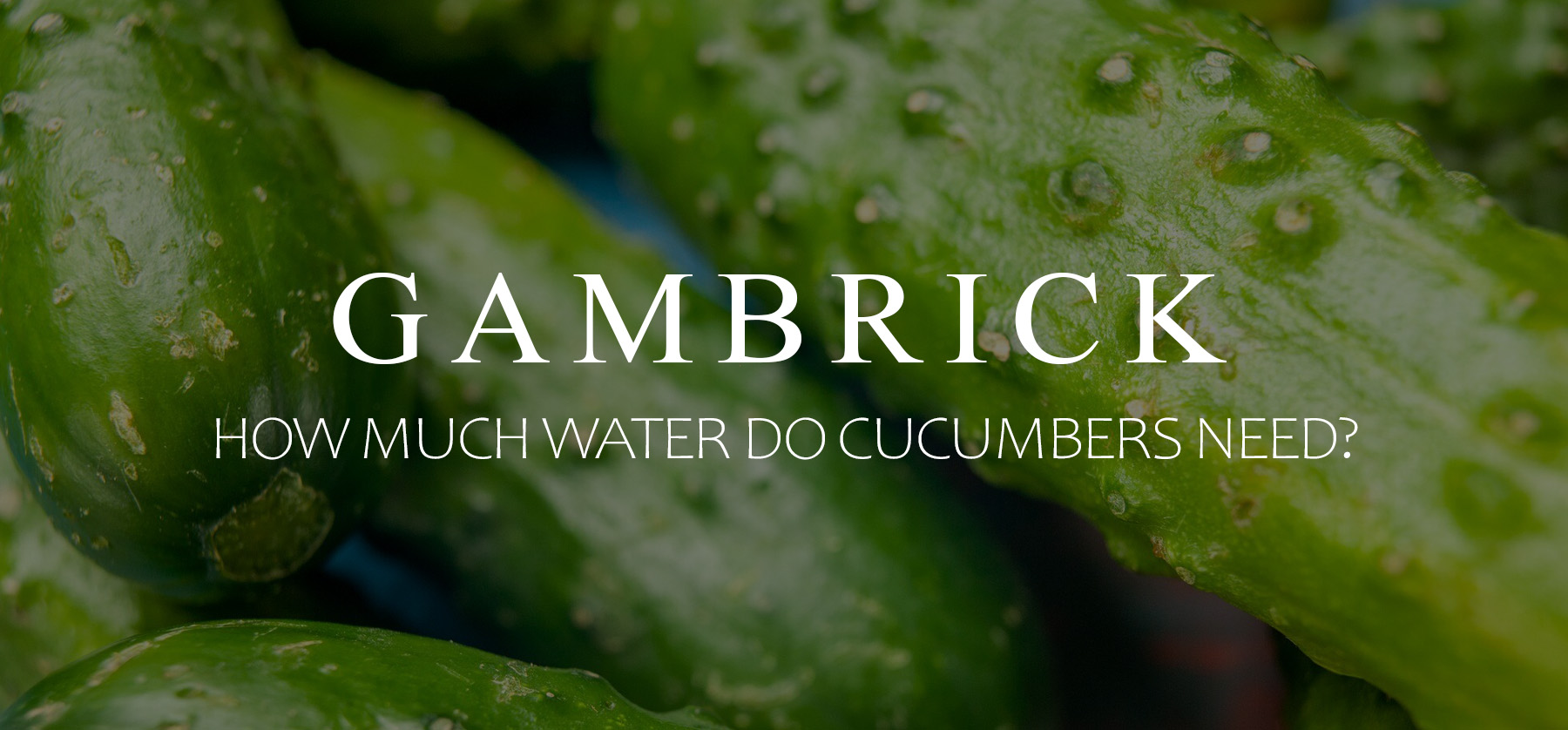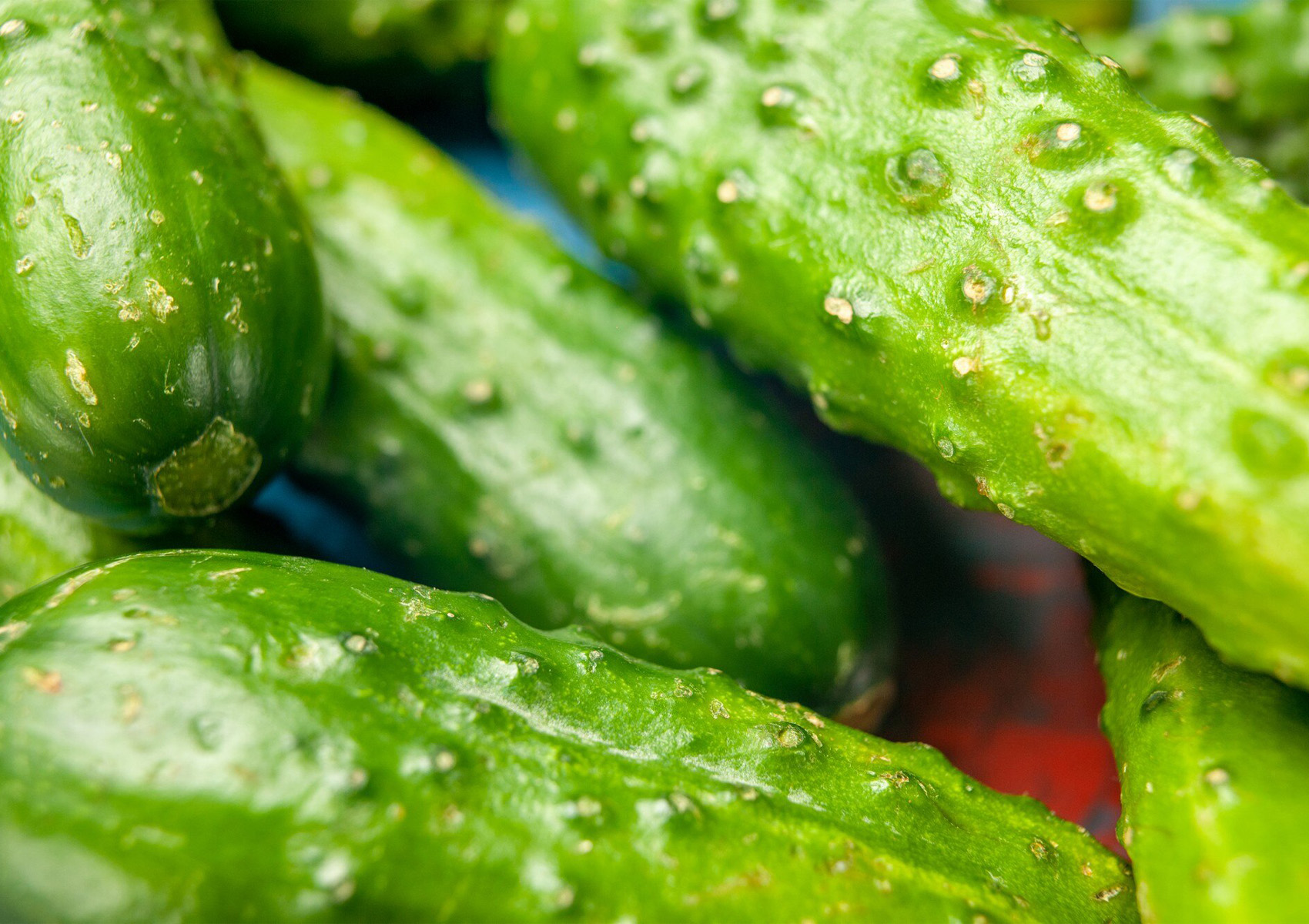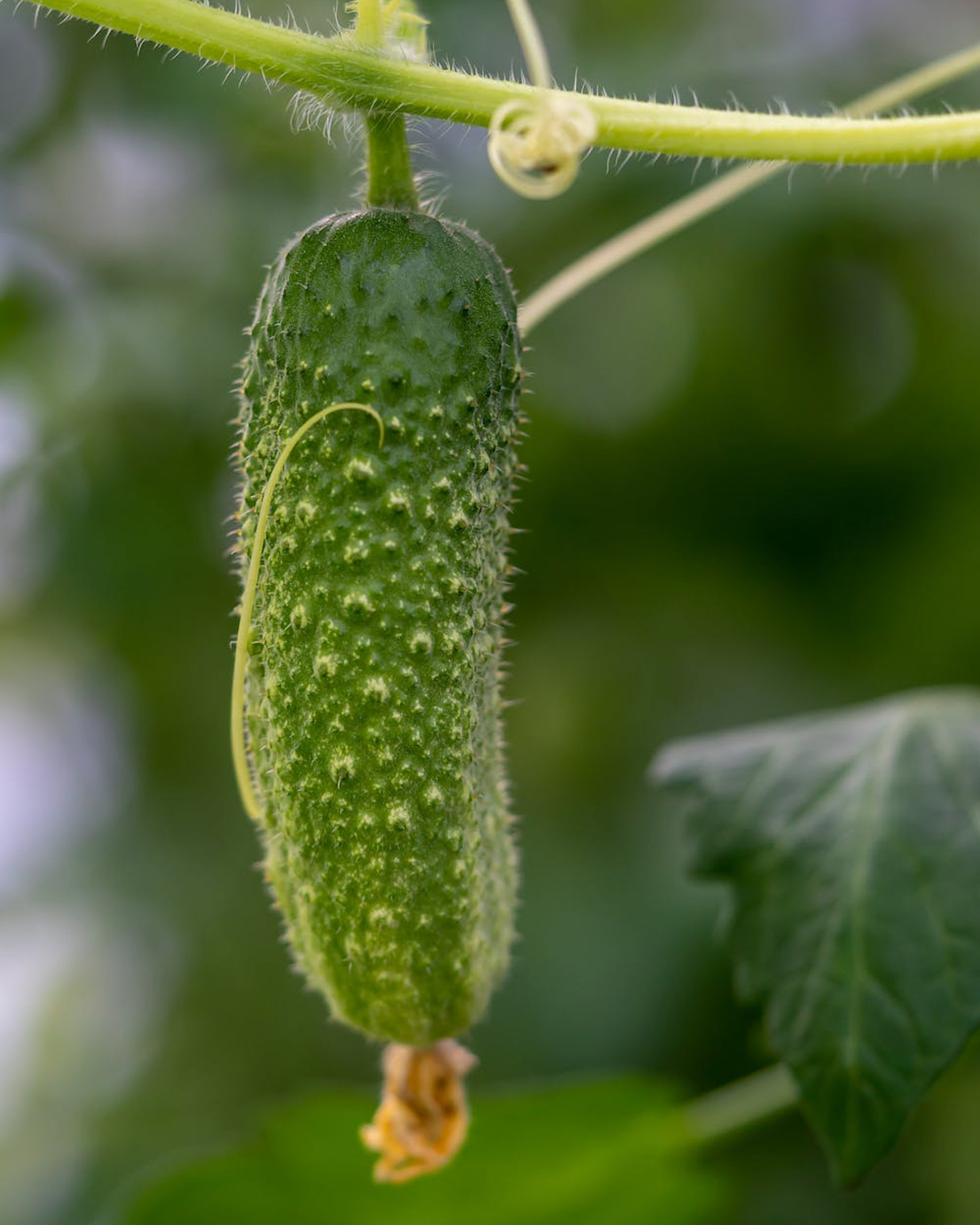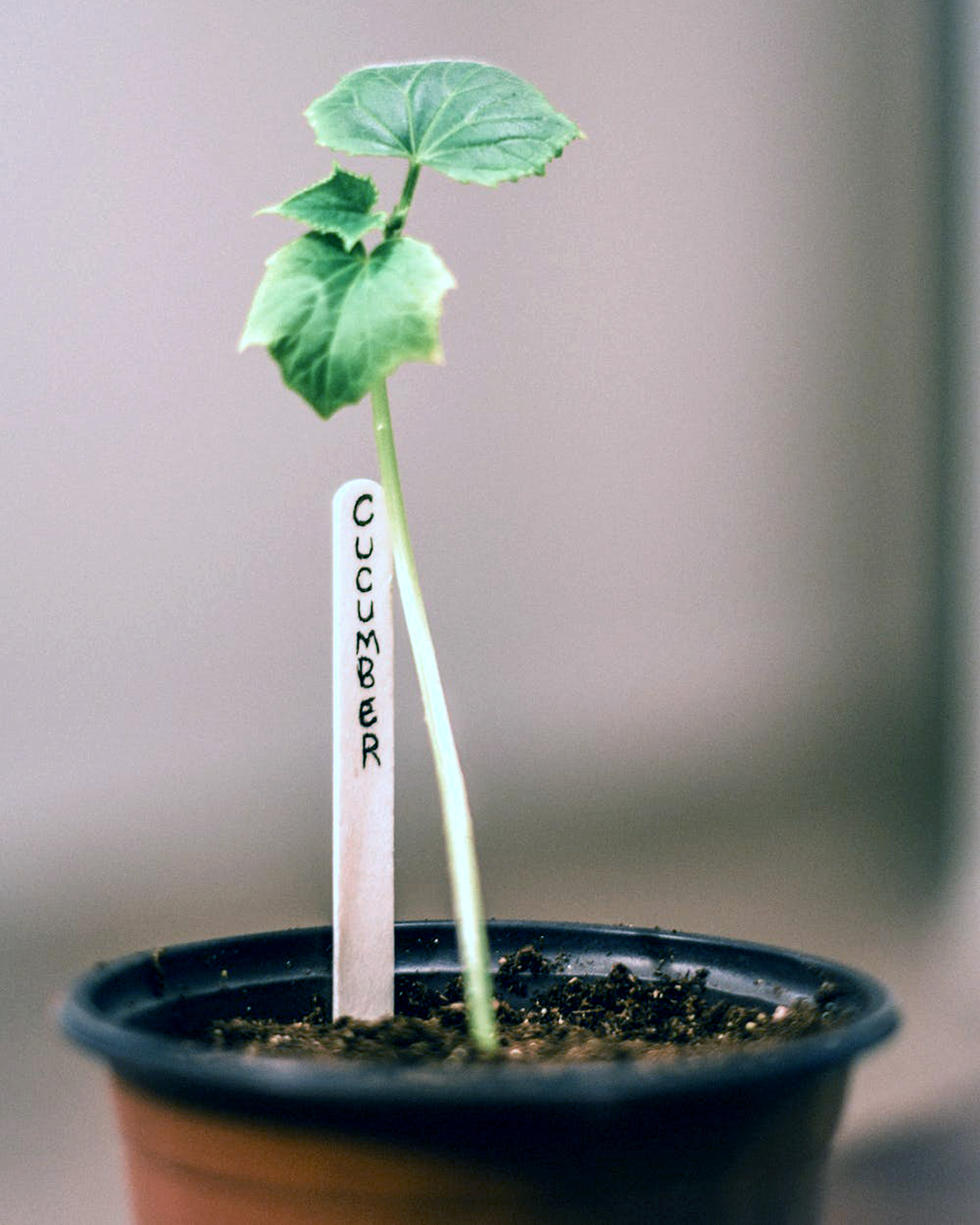How Much Water Do Cucumbers Need?
Cucumbers need 1-2 inches (2.5–5 cm) of water per week with a consistently moist soil. Give them more water if temperatures get hot, it doesn’t rain or the air is extremely dry and less if it’s damp outside or rainy. If you under-water or inconsistently water cucumbers, the fruit could be misshapen or poor-tasting. Water your cucumbers with a soaker hose or drip irrigation to keep the leaves dry and the soil moist. This creates the best growing environment for cucumber plants.
Provide a steady water supply immediately after planting, then increase to heavier watering after the cucumbers bloom. Water cucumbers every 2–3 days in spring to keep the soil most, then increase to 4–6 times per week in summer.
Cucumbers are a tropical vegetable that thrive with lots of water and hot weather. The plants are sensitive to cold, so they shouldn’t be set into the garden until soil temperatures are reliably in the 70-degree range and no less than 2 weeks after the last frost date.
Cucumber plants grow in two forms: vines and bushes.
- Vine cucumbers grow along the ground or up trellises. They typically grow the most fruit per season.
- Bush types form a more compact plant. They’re better suited for containers and small gardens.
To increase your season’s cucumber yield of both plant varieties, plant several crops in succession 2 weeks apart, give them 1-2 inches of water per week and keep the soil moist.
How Often Should You Water Cucumber Plants?
How often you should water cucumber plants depends on where they’re planted. Cucumbers need 1-2 inches (2.5-5 cm) of water per week depending on weather conditions. If it’s hot out or very dry they need more water. However, if it’s cloudy or damp out, they need less. The key to successfully growing healthy cucumbers that taste great is keeping the soil moist. They don’t like dry soil or too much water.
- If your cucumbers are in a pot or a greenhouse where you can control the temperature, direct sunlight and humidity, it’s easier to stay on a set watering schedule.
- If your cucumbers are planted outdoors in a garden, you need to adjust how often you water based on weather conditions, temperature and direct sunlight.
To know when it’s time to water your cucumbers again, check the soil. Use your finger or a moisture meter to see if the soil is damp below the surface. If it’s dry, add water.
Cucumbers don’t like being over-watered or under-watered. If water pools on the surface of the soil, you’ve given the plant too much.If the soil is dry, you need to water the plants.
Under and over watering cucumbers will result in oddly shaped fruits and/or poor flavor. If you severely under or over water them, they could turn yellow, droop, develop a fungal infection or die.
How Much Water Do Cucumber Seedlings Need?
Cucumber seedlings require less water than when the plant has flowered. As a seedling, cucumber plants need 1 inch (2.5 cm) of water per week with consistently moist soil. Give them more water if temperatures get hot or the air is extremely dry. Water them with a soaker hose or drip irrigation to keep the leaves dry and the soil moist. This creates the best growing environment for cucumber plants.
- Check the moisture content in the soil multiple times a day with your finger or a moisture meter. The soil should always be damp below the surface but not too wet or dry.
- If you under-water or inconsistently water cucumbers, the fruit could be misshapen or poor-tasting.
- If cucumber plant seedlings are grown in bunches, they may soak up moisture faster. Make sure to check the soil’s moisture content more often if you have lots of seedlings planted in bunches.
- It’s better to water cucumber seedlings lightly and more frequently than watering them a lot but less frequently.
- Seedlings are more susceptible to “drowning” when they’re over-watered.
- Too much water at once can cause a seedling to uproot itself so add water slowly at first.
I water my cucumber seedlings a little every day. Make sure to keep an eye on how moist the soil is. No matter what your watering schedule says, if the soil is dry, add water.
Cucumber seedlings show signs of over or under watering faster than a full grown plant. If your plant is wilting or turning yellow and the soil is dry, it probably needs water.
How Much Water Do Flowering Cucumber Plants Need?
Flowering cucumber plants require more water than seedlings. When your cucumber plants start to flower in Summer, up their water to 2 inches (5 cm) per week with consistently moist soil. Give them more water if temperatures get hot or the air is extremely dry. Water them with a soaker hose or drip irrigation to keep the leaves dry and the soil moist. This creates the best growing environment for cucumber plants.
- Check the moisture content in the soil at least once a day with your finger or a moisture meter to make sure it stays damp.
- It’s better to water cucumbers lightly and more frequently than watering them a lot but less frequently.
I water my flowering cucumber plants a little every day to make sure the soil stays moist. No matter what your watering schedule says, if the soil is dry, add water.
Flowering cucumber plants show signs of over or under watering slower than a seedling. If your plant is wilting or turning yellow and the soil is dry, it desperately needs water.
How Much Water Do Garden Cucumbers Need?
Cucumbers grown in a garden outdoors need 1-2 inches (2.5–5 cm) of water per week with a consistently moist soil. Give them more water if temperatures get hot or the air is extremely dry and less if it’s damp. Water your outdoor cucumbers with a soaker hose or drip irrigation to keep the leaves dry and the soil moist. This creates the best growing environment for cucumber plants.
- Provide a steady water supply immediately after planting your cucumbers. Then increase to heavier watering after the cucumbers bloom.
- Water cucumbers every 2–3 days in spring to keep the soil most, then increase to watering them every day in summer.
Because cucumbers grown in an outdoor garden receive more direct sunlight than those grown in a greenhouse, they lose more water due to evaporation. Make sure to check the soil’s moisture content multiple time a day to keep it moist.
If you check your soil and it’s feels dry, water the plants. It doesn’t matter what your watering schedule says, cucumbers require damp soil to thrive.
How Much Water Do Indoor Cucumbers Need?
Cucumbers grown indoors need 1 inch (2.5) of water per week with a consistently moist soil. Water them with a soaker hose or drip irrigation to keep the leaves dry and the soil moist. This creates the best growing environment for cucumber plants.
Because cucumbers grown indoors receive less direct sunlight than those grown outdoors and you can control the moisture content in the air, they lose less water due to evaporation. This means you can stay on a more consistent watering schedule.
- Provide a steady water supply immediately after planting your cucumbers. Then increase to heavier watering after the cucumbers bloom.
- Water cucumbers every 2–3 days in spring to keep the soil most, then increase to 4–6 times per week in summer.
- Make sure to check the soil’s moisture content every day to keep it moist.
If you check your soil and it’s feels dry, water the plants. It doesn’t matter what your watering schedule says, cucumbers require damp soil to thrive.
How Much Water Do Cucumbers Need Per Day?
Cucumbers need 1-2 inches (2.5-5 cm) of water per week depending on weather conditions. If it’s hot out, very dry or doesn’t rain, they need more water. However, if it’s rainy or damp out, they need less. The key to successfully growing healthy cucumbers that taste great is consistent watering. The soil should always stay moist. If you under-water or let the soil dry out, the fruit could grow oddly shaped or develop an odd-taste.
Cucumber plants benefit from a consistent watering schedule that keeps the soil moist. They’re a sensitive tropical plant that like hot weather, water and damp soil. If you deprive them of any of these 3 things, they won’t grow properly.
Inconsistent or too little moisture can cause problems with your cucumber fruits.
- 1 inch (2.5 cm) of water per week is ideal before cucumbers bloom.
- 2 inches (5 cm) of water may be needed in hot and dry weather before they bloom.
- Increase their water supply to 2 inches (5 cm) per week on average once your plants begin blooming but remember to adjust for weather conditions.
- Water cucumbers 2–3 times weekly before blooms set.
- Once you see blooms appear, increase your watering frequency to 4–6 times per week.
- Remember to always keep the soil moist.
I always double my watering frequency once the plants start to bloom. Watering them 2–3 per week is best in spring unless it’s especially hot. When you see your first cucumber flowers in Summer, increase watering to at least 4–6 times per week.
Check the soil with your finger each morning to make sure it’s moist. If it’s dry, add more water no matter what your watering schedule is.
How Do You Water Cucumbers?
The best way to water cucumbers is with drip irrigation or a soaker hose. The reason why is because cucumber plants like moist soil. Other types of watering, like spray hoses, waste water by spraying it onto the leaves which allows the soil to become dry.
When watering cucumbers, use drip irrigation or a soaker hose to keep the soil moist. Avoid spraying water onto the foliage because it doesn’t moisten the soil.
- Drip irrigation: Provide just enough water to keep the soil consistently moist.
- Soaker hose: Place the hose a few inches from the base of the plant and water on a consistent schedule. Set the hose to a low setting and let the water flow until the soil becomes moist.
No matter which method you use, stop watering once water begins pooling on the surface. Cucumbers are very sensitive plants. If they’re under-watered, over-watered or inconsistently watered, they could grow oddly-shaped or with an odd-taste.
- A drip irrigation system or a soaker hose is the best way to water cucumbers because they keep the soil moist.
- Avoid getting the foliage wet.
- Don’t under-water or over-water cucumber plants.
- Always water your cucumbers consistently and keep the soil moist.
- Check the soil around the base of your plant with your finger to make sure it’s not dry.
Always water cucumbers at ground level instead of spraying and try not to get the cucumber leaves wet. Wet foliage can cause discoloration and leaf diseases and prevents the water from seeping into the soil.
Keeping the foliage dry and the soil damp is important for proper growth and the long-term health of your cucumbers.
Do Cucumbers Like Wet Or Dry Soil?
Cucumbers like moist soil that’s not too wet or too dry. This is why you should slowly water them with drip irrigation or a soaker hose rather than a sprayer. They need 1-2 inches (2.5–5 cm) of water per week on a slow and consistent basis that keeps the soil damp. Vary your watering schedule based on the temperature, rainfall and humidity in the air.
You can check how moist the soil is with your finger. I typically check every morning and again at mid day when the temperature is hottest. If the soil feels dry, water the cucumbers no matter what your watering schedule says.
Cucumbers are very sensitive when it comes to soil moisture. If the soil is too wet or too dry the could grow oddly-shaped or with a poor-taste. It’s essential to maintain moist soil without dry areas or pooling water.
- Cucumbers thrive in moist soil that’s not too wet or too dry.
- Soil that’s too wet or too dry can make the cucumbers grow oddly-shaped or with a poor-flavor.
- You can use a moisture meter or your finger to check the soil conditions.
Invest in a moisture meter if you want help keeping the soil moist enough for optimal growth. They’ll help track your soil’s moisture levels so you can adjust your watering schedule when needed. Over time, this will result in healthier cucumbers with higher yields.
Can You Over Water Cucumbers?
Yes, cucumbers like moist soil that’s not too wet or dry. It is very easy to over water them which can lead to cell damage, yellowing, rot, fungal disease, odd shapes, a poor-favor or the plants could outright die. If you see pools of water on the soil, you’re giving the cucumbers too much water.
The best way to water a cucumber plant is slow and even using drip irrigation or a soaker hose. They need 1-2 inches (2.5–5 cm) of water per week depending on the temperature and weather conditions. They also need more water once they start to flower. Give them 1 inch (2.5 cm) per week on average in Spring when you first plant them and 2 inches (5 cm) on average when they flower in Summer.
- Over watering cucumbers can cause cell damage, rot, yellowing, fungal disease, oddly-shaped growth and/or poor-taste.
- If you see pools of water on the soil you’re giving the cucumbers too much water.
- The soil should be moist but not wet or dry.
- Use a moisture meter to help prevent over-watering.
- Water on the ground and try not to get the leaves wet.
A great way to help prevent over-watering is to plant your cucumbers in the correct soil. Fertile, well-draining soil is recommended because it promotes good drainage and helps prevent water-logged roots.
Planting in a raised bed with potting soil and some compost mix creates great conditions for cucumbers.
Make sure to slow water your cucumbers and check the soil often to make sure it stays moist.
How Do You Know If Cucumbers Need Water?
The best way to tell if your cucumbers need water is by checking the soil. Cucumbers grow best in moist soil that’s not too wet or too dry. You can check the moisture content in your soil with your fingers or by using a moisture meter.
- Push a finger down into the soil near the base of the plant to see if it’s damp. If the soil is dry below the surface, the cucumbers need water.
- Moisture meters work similar to using your finger except they use sensors to detect water. Push the leads down into the soil and the meter will tell you the soil’s moisture content.
Cucumbers require 1-2 inches (2.5–5 cm) of water per week depending on the temperature and weather conditions. They also need more water once they start to flower. Give them 1 inch (2.5 cm) per week on average in Spring when you first plant them and 2 inches (5 cm) on average when they flower in Summer.
Cucumbers like a steady and even water supply. Slowly water your cucumbers with drip irrigation or a soaker hose.
You can tell if cucumbers need water by inspecting the leaves. If your cucumbers are wilting, losing leaves, and/or yellowing, they’re in desperate need of water.
- Under-watered cucumbers will start to yellow, lose leaves and wilt.
- Check the soil with a finger or moisture meter regularly to see if it’s too dry.
- If the soil is dry, water your cucumbers.
- Cucumbers require soil that’s consistently moist.
Cucumbers grow best when the soil is kept moist. Insufficient water content and/or dry soil can cause them to grow in odd shapes and/or develop a poor-flavor. For best results, check the moisture content in your soil at least 1-2 times per day and add water as needed.
How Much Water Do Cucumbers Need Per Week?
Cucumbers require 1-2 inches (2.5–5 cm) of water per week depending on the temperature and weather conditions. They also need more water once they start to flower. Give them 1 inch (2.5 cm) per week on average in Spring when you first plant them and 2 inches (5 cm) on average when they flower in Summer.
- Give cucumbers more water when it’s extremely hot or dry outside.
- To find out if your cucumbers need water, check the soil.
- Cucumbers grow best when the soil is always kept moist.
- Do not over or under water cucumbers or they’ll grow in odd shapes and develop an odd flavor.
Cucumbers grow best when they have a consistent and even watering schedule.Water them on the ground near their base and avoid getting water on the leaves. Use drip irrigation or a soaker hose for best results.
Here are some important things to remember when watering cucumber plants:
- Cucumbers need 1–2 inches (2.5–5 cm) of water each week on average.
- Water cucumbers 2–3 times each week before they flower.
- As soon as cucumbers flower, double the watering frequency to 4–6 times each week.
- Cucumbers are best watered using drip irrigation or a soaker hose.
- Check your soil to make sure it stays moist.
- Adjust your watering schedule based on the temperature and weather conditions.
- Don’t over or under water your cucumbers.
- Don’t get water on the leaves.
Cucumbers grow best when they get enough water and the soil is kept moist. Insufficient water content and/or dry soil can cause them to grow in odd shapes and/or develop a poor-flavor. For best results, check the moisture content in your soil at least 1-2 times per day with your finger or a moisture meter, and add water as needed.
Tips For Planting Healthy & Flavorful Cucumbers
Cucumbers are a tropical plant that thrives in warm, fertile soil with a pH of 6.0 to 6.8. However, they will tolerate a pH up to 7.6. To improve your soil, mix several inches of compost or Miracle-Gro into the top few inches of your garden soil. Then plant seedlings 36 to 60 inches apart, depending on variety. For vine cucumbers on a trellis, space plants 1 foot apart.
- Plant cucumbers when average daily temperatures reach the mid-70s° F.
- In areas where temperatures are cool, you can warm the soil 3 to 4 degrees by covering the row with black plastic or using mulch made from pine straw, wheat straw, chopped leaves, or an organic mulch shortly after planting.
- If the weather is cool, wait to mulch until the ground is warmed by the sun.
- Mulch helps keep the fruit clean for bush types and vines not growing on a trellis.
- Straw mulch helps keep slugs and cucumber beetles away.
- Trellis your vines to keep the fruit clean and save space.
- A 12- to 18-inch diameter cage made from 4- or 5-foot welded wire fencing can support 2 or 3 vines.
- Feed plants with a water-soluble plant food.
Cucumbers grow fast when properly watered and don’t require too much attention. Make sure to keep the soil consistently moist with an inch or two of water per week (adjust based on weather conditions and temperature).
Inadequate or inconsistent moisture causes oddly shaped and/or odd-tasting fruit. Water your cucumbers with a soaker hose or drip irrigation to keep the foliage dry and the soil moist.
Check the soil for moisture every day with your finger or a moisture meter.
Summary: How Much Water Do Cucumbers Need?
Cucumbers need 1-2 inches (2.5–5 cm) of water per week with a consistently moist soil. Give them more water if temperatures get hot, it doesn’t rain or the air is extremely dry and less if it’s damp outside or rainy. If you under-water or inconsistently water cucumbers, the fruit could be misshapen or poor-tasting. Water your cucumbers with a soaker hose or drip irrigation to keep the leaves dry and the soil moist. This creates the best growing environment for cucumber plants.
Provide a steady water supply immediately after planting, then increase to heavier watering after the cucumbers bloom. Water cucumbers every 2–3 days in spring to keep the soil most, then increase to 4–6 times per week in summer.
Cucumbers are a tropical vegetable that thrive with lots of water and hot weather. The plants are sensitive to cold, so they shouldn’t be set into the garden until soil temperatures are reliably in the 70-degree range and no less than 2 weeks after the last frost date.
Cucumber plants grow in two forms: vines and bushes.
- Vine cucumbers grow along the ground or up trellises. They typically grow the most fruit per season.
- Bush types form a more compact plant. They’re better suited for containers and small gardens.
To increase your season’s cucumber yield of both plant varieties, plant several crops in succession 2 weeks apart, give them 1-2 inches of water per week and keep the soil moist.
If you have any questions or comments, email any time.

























